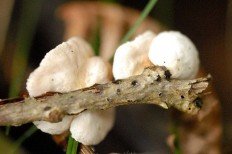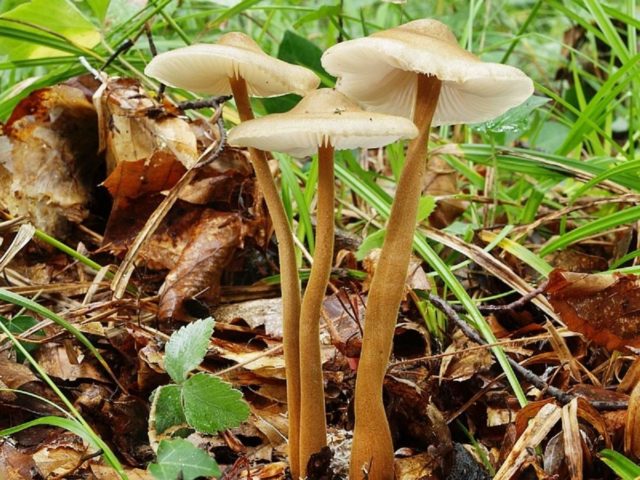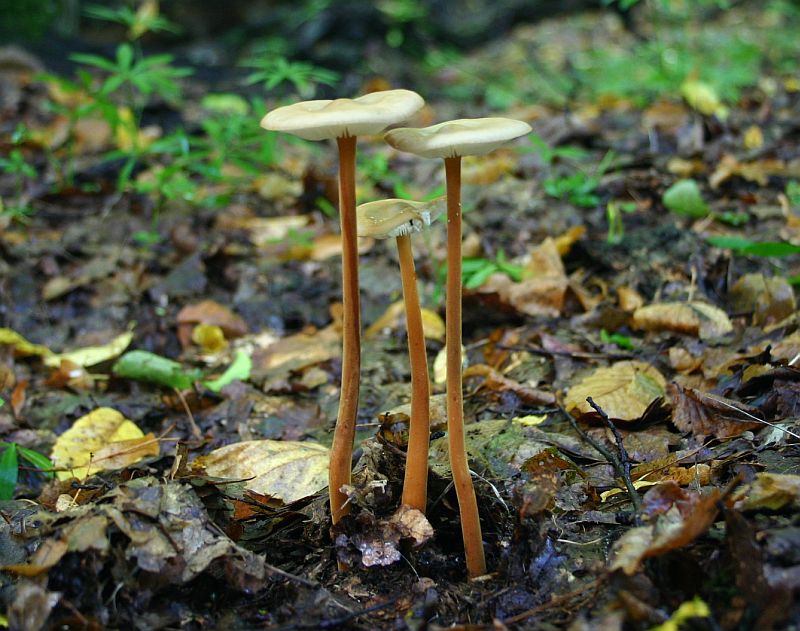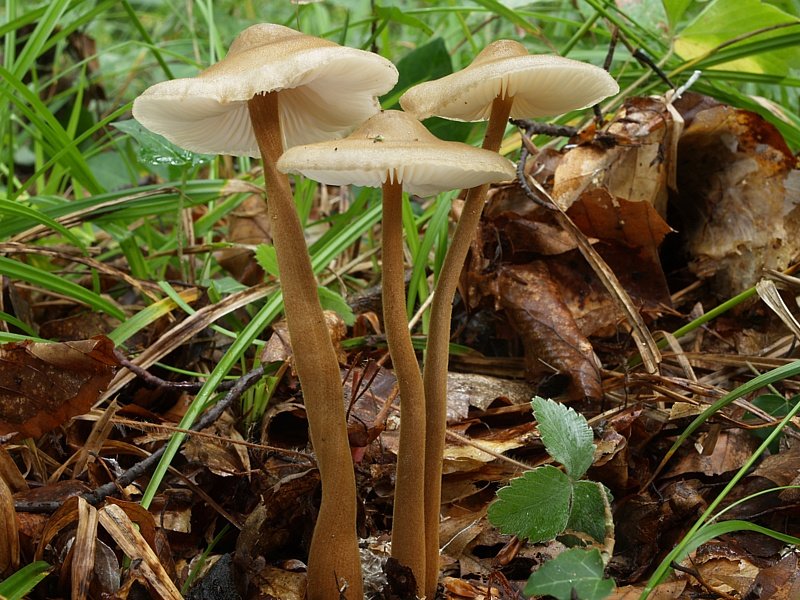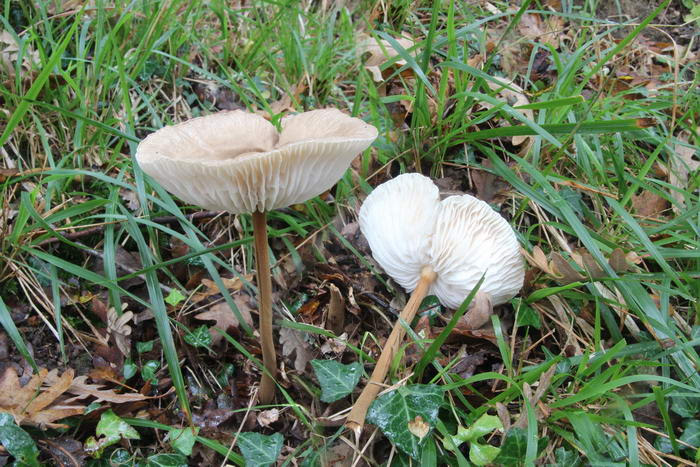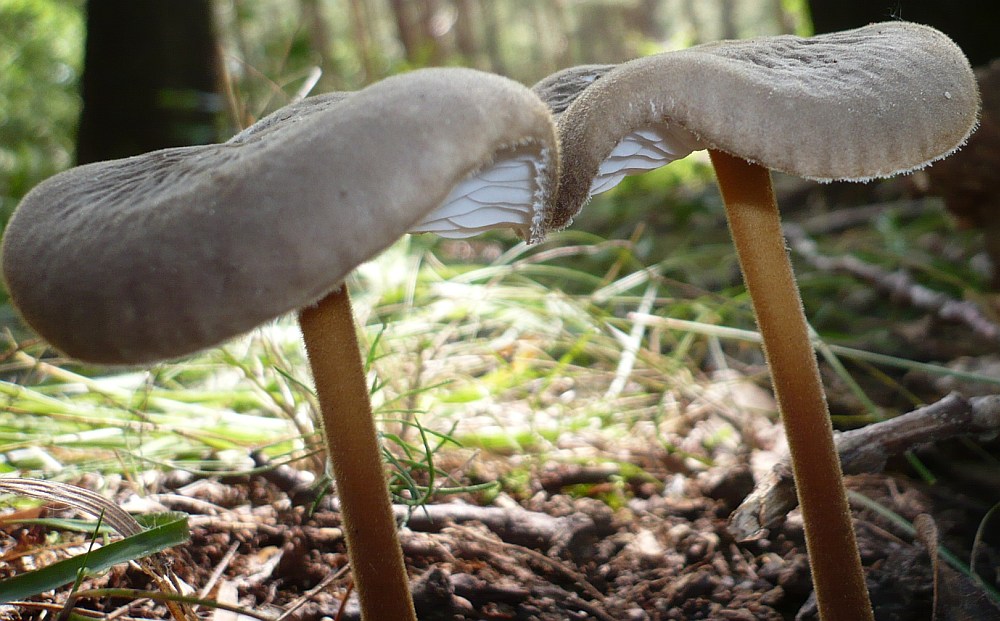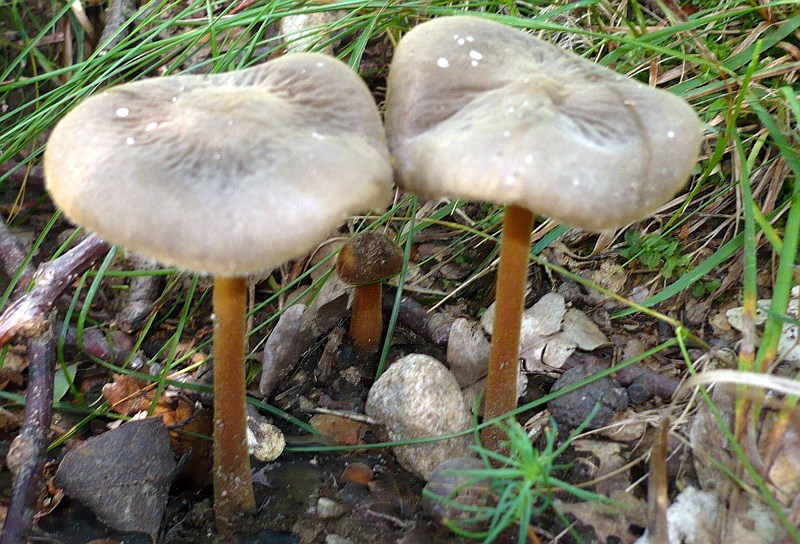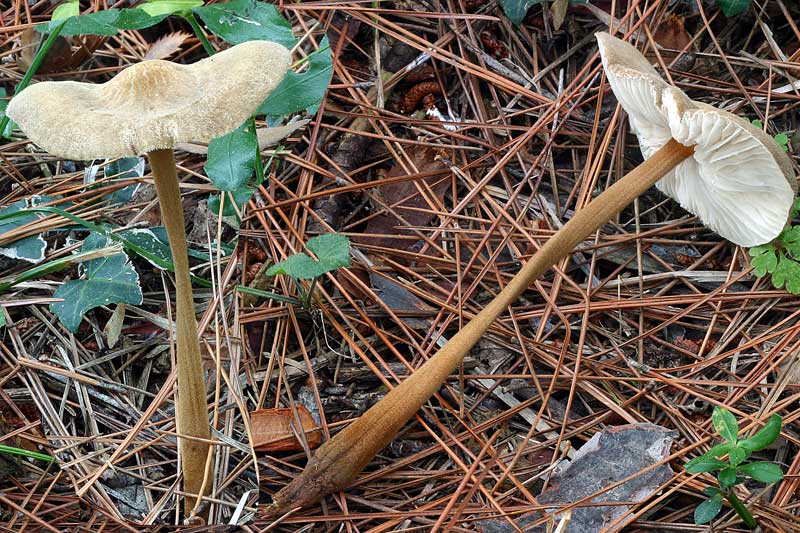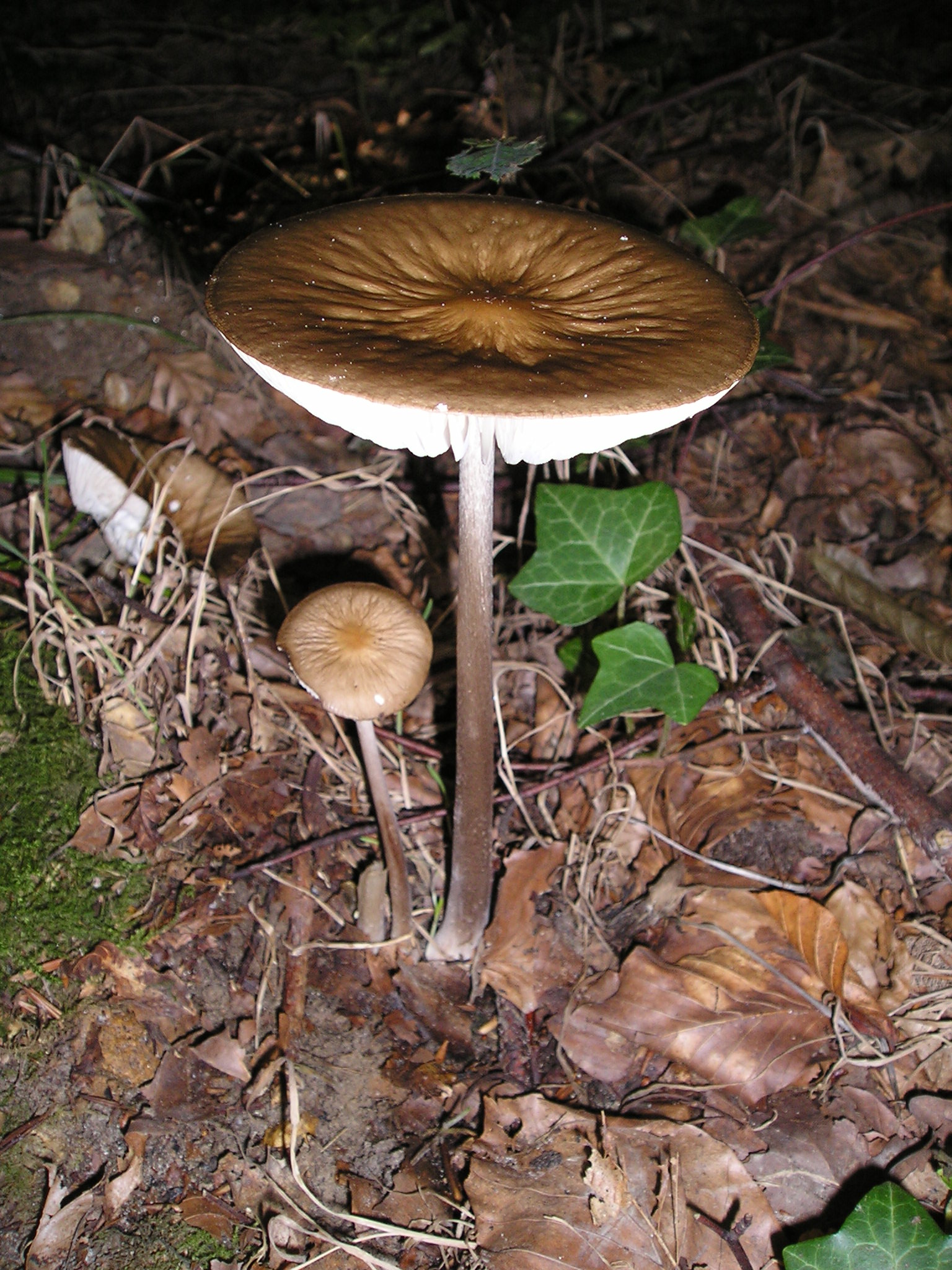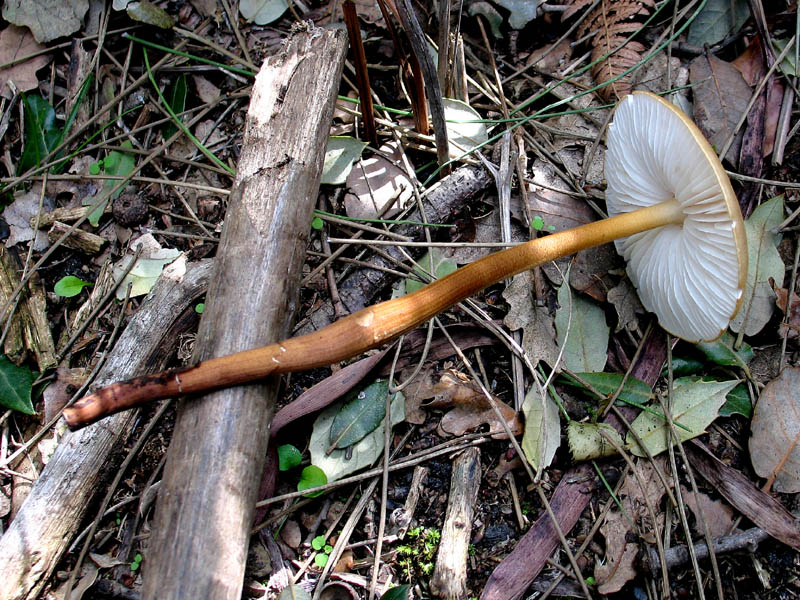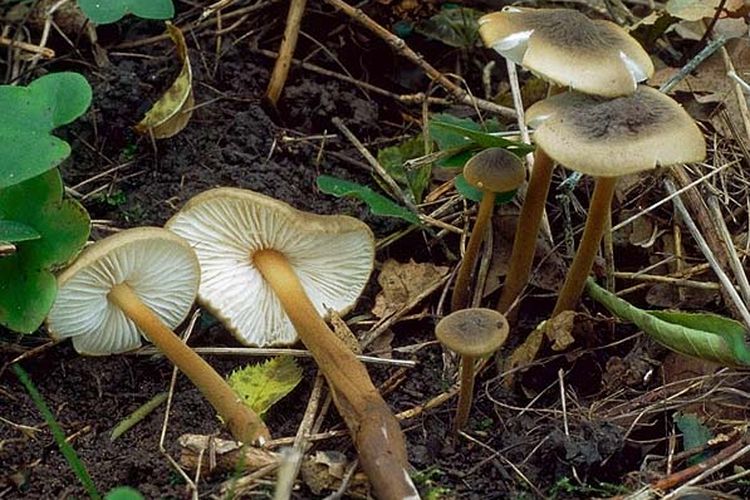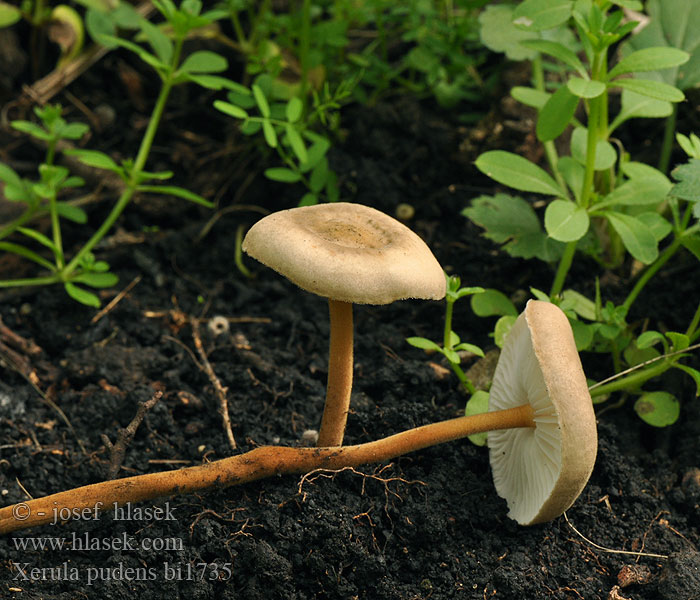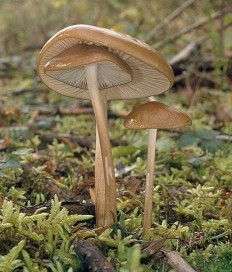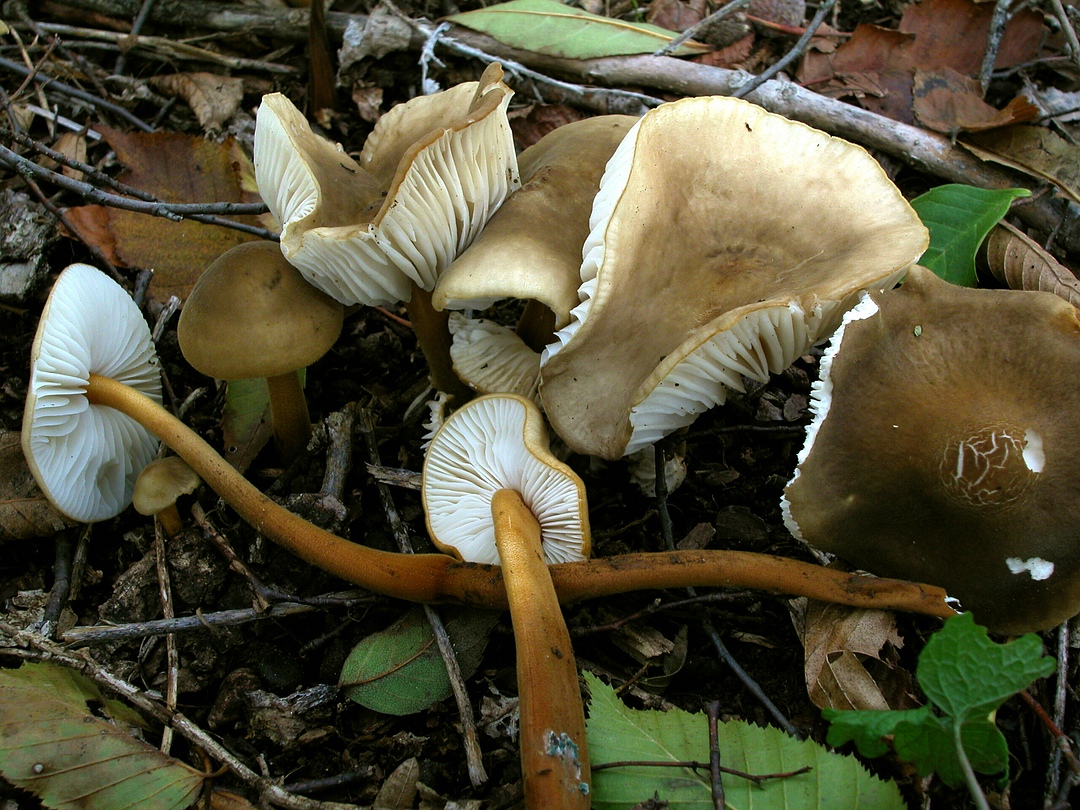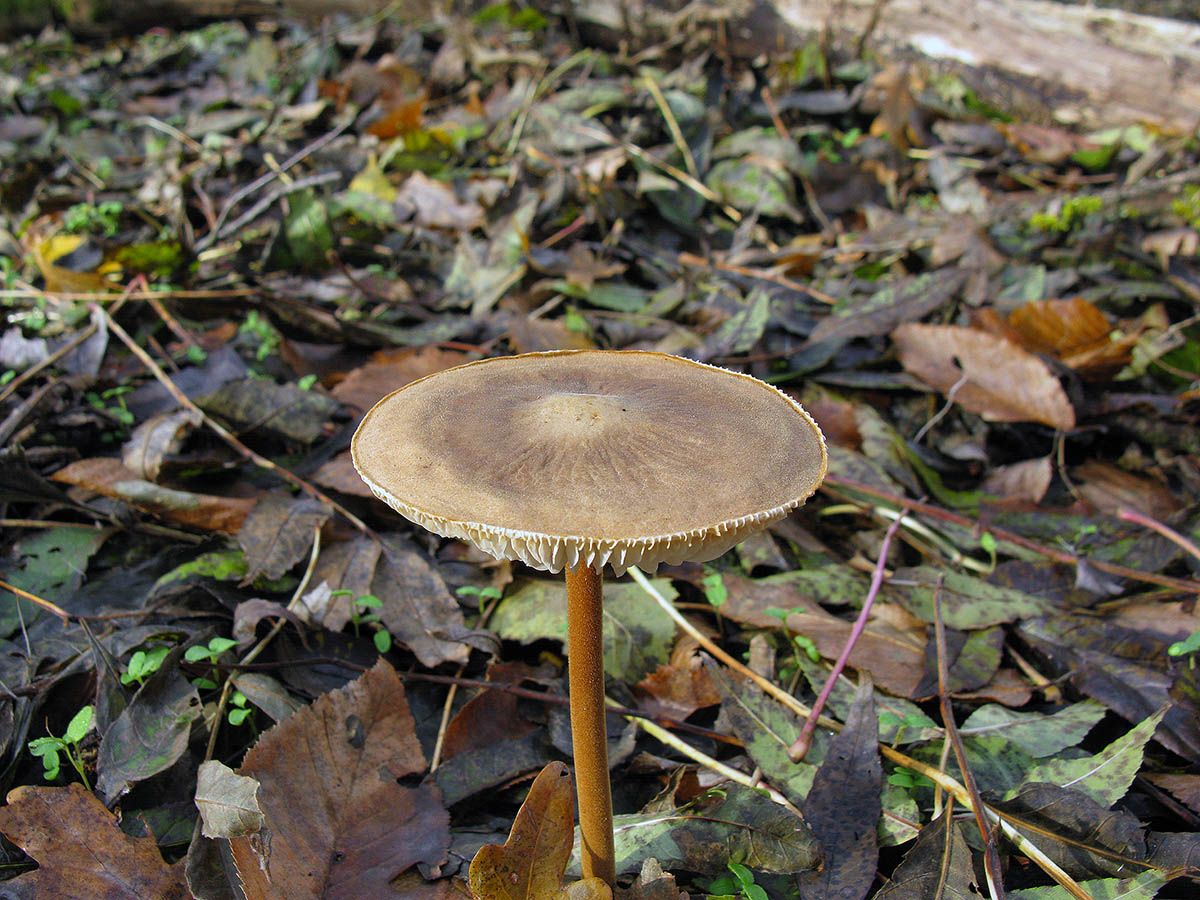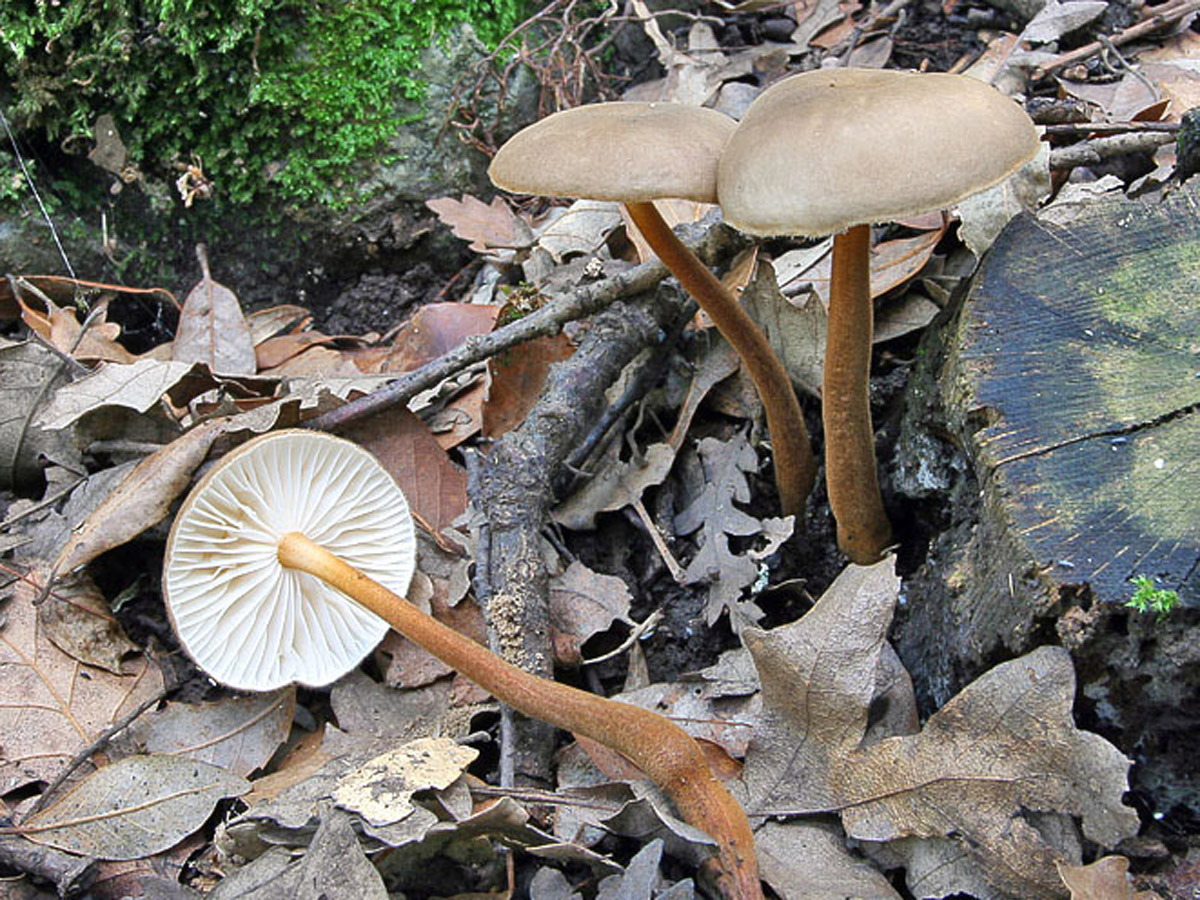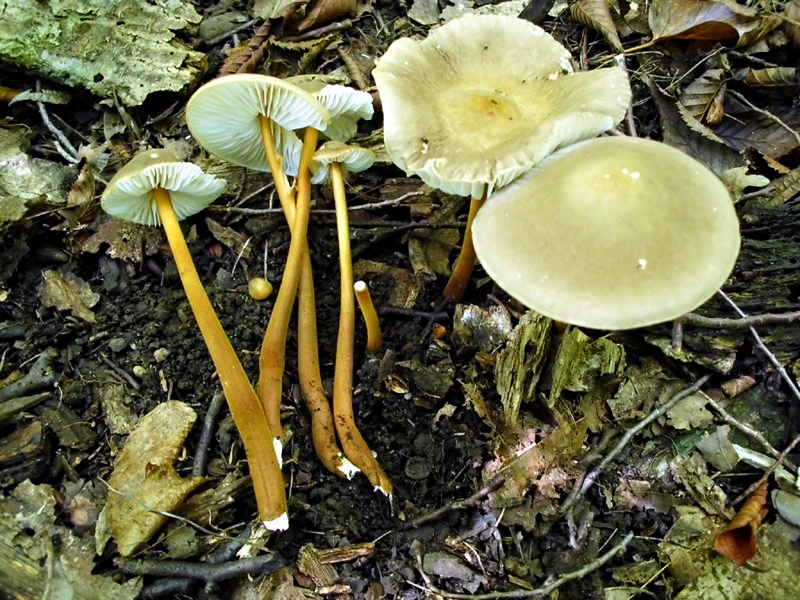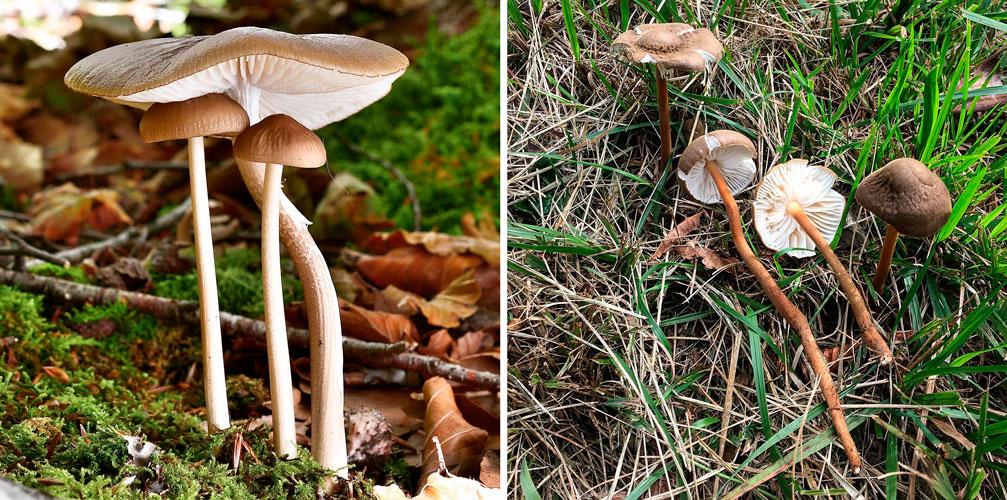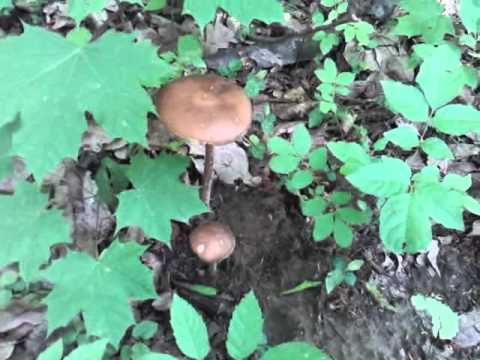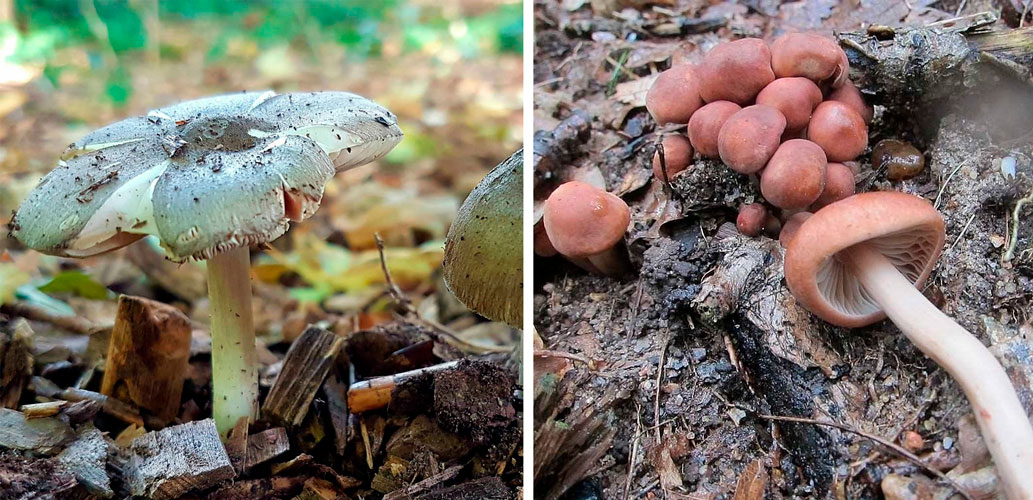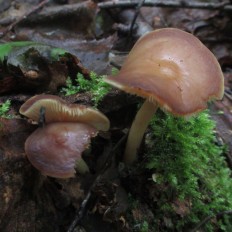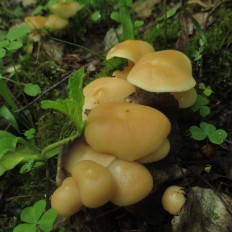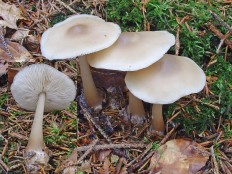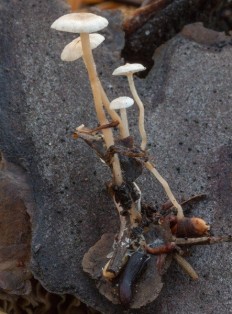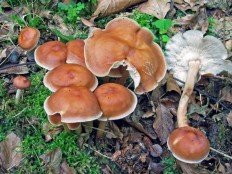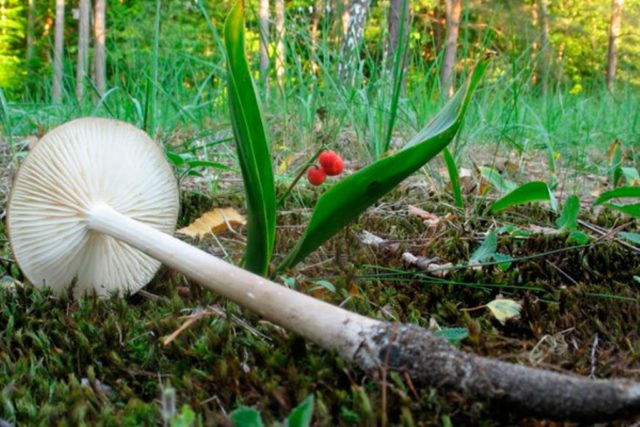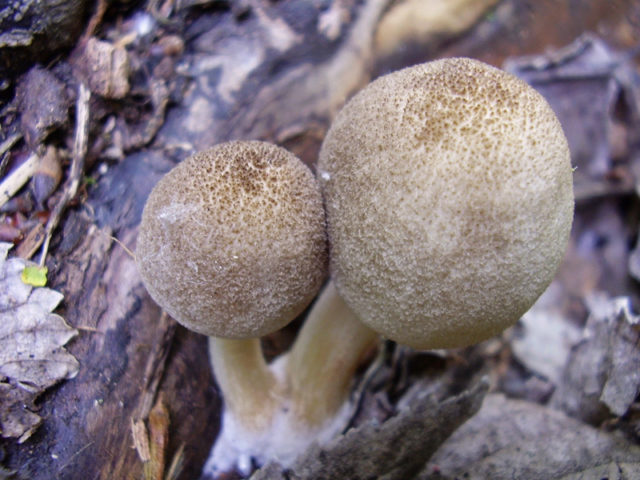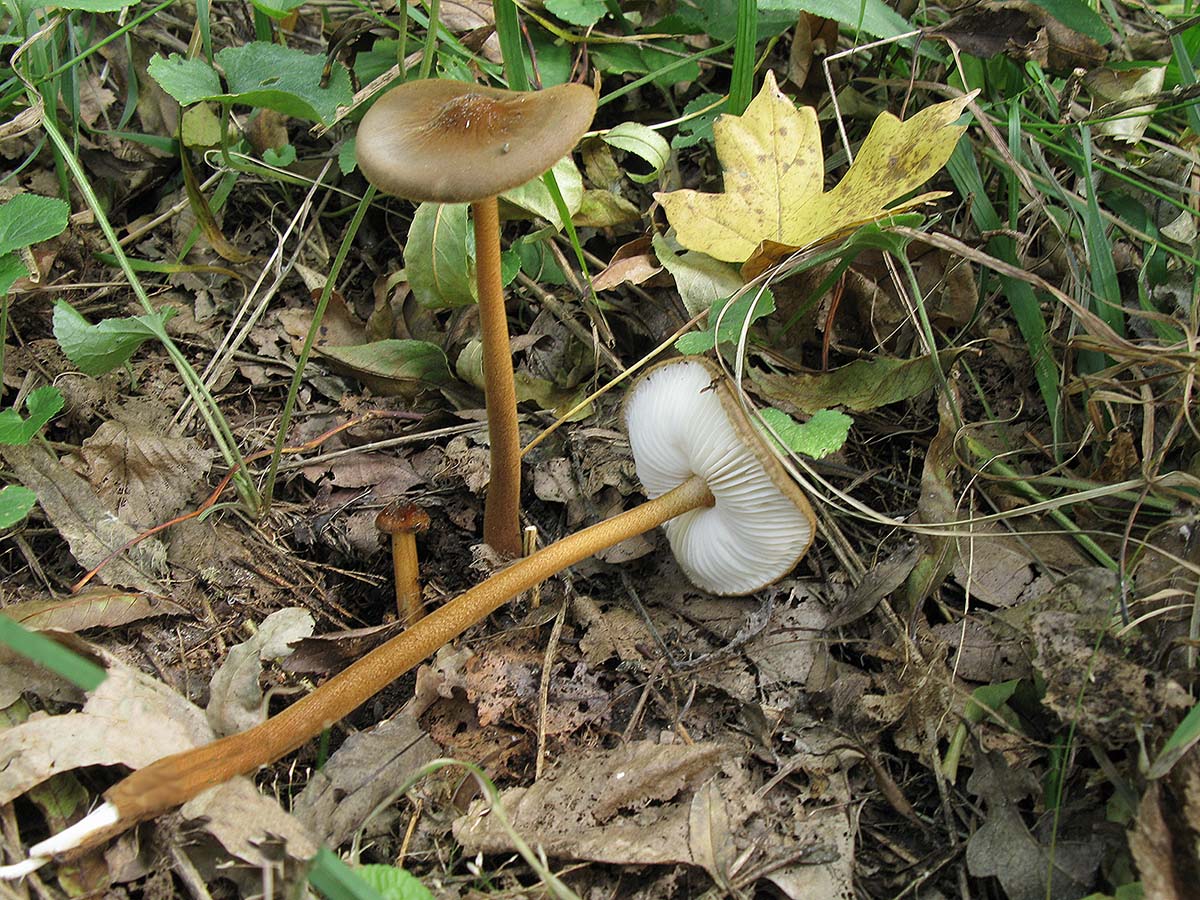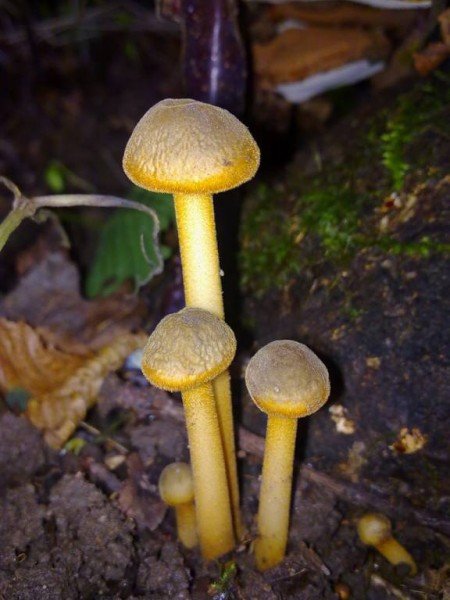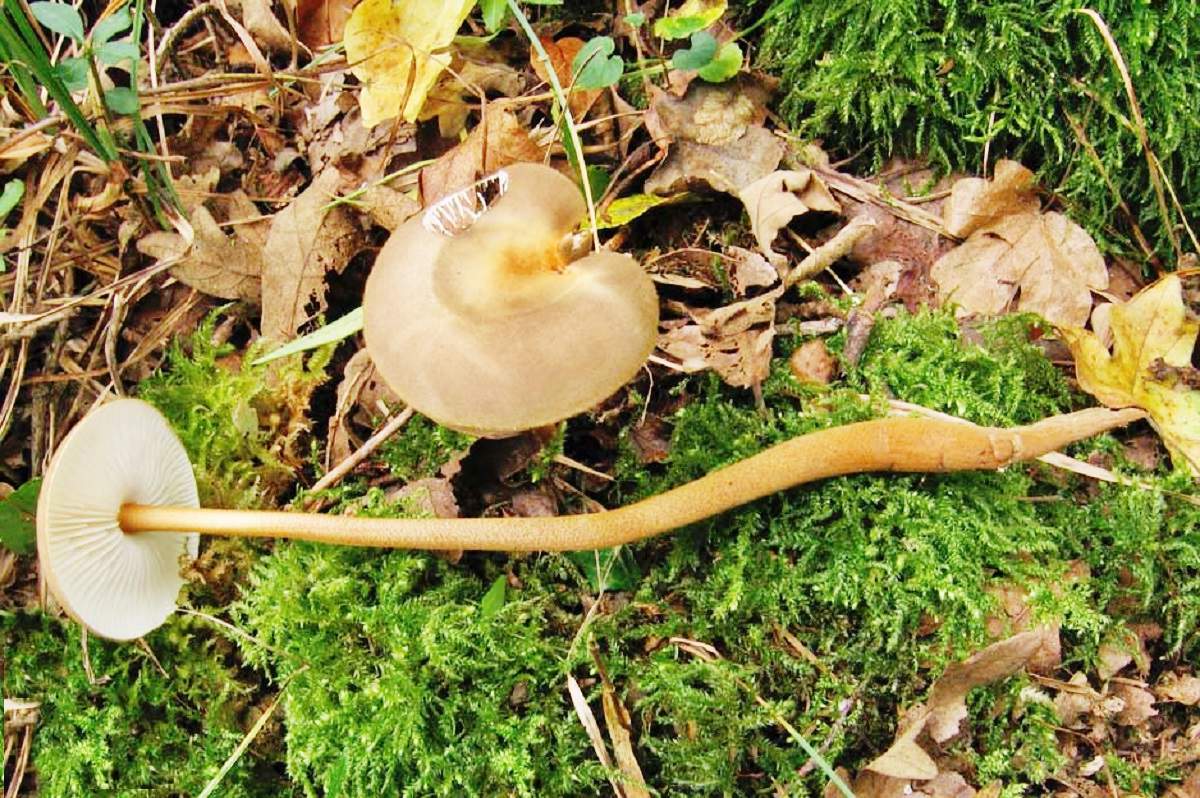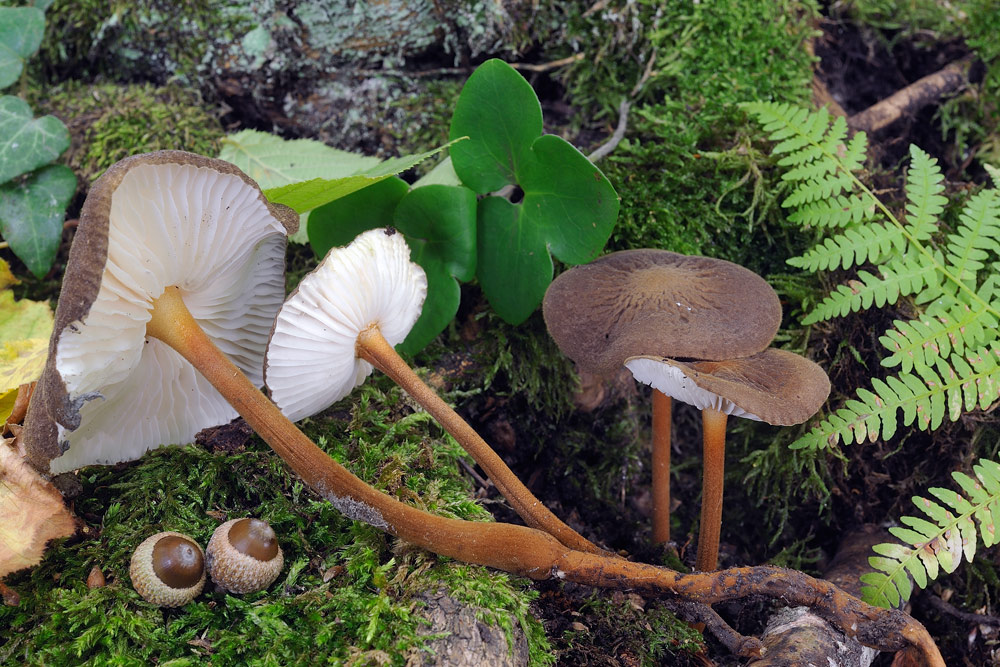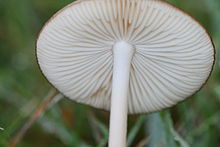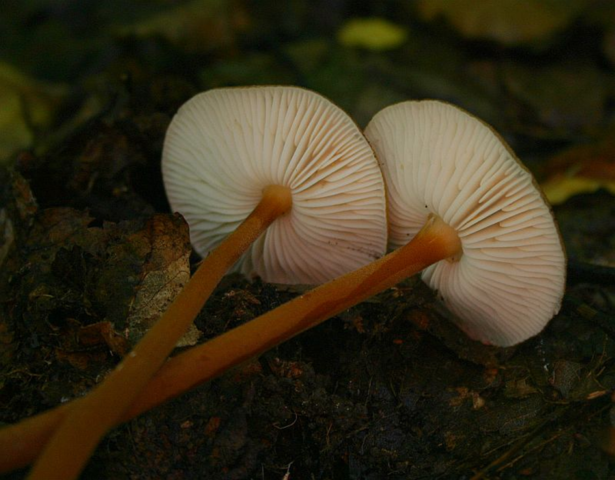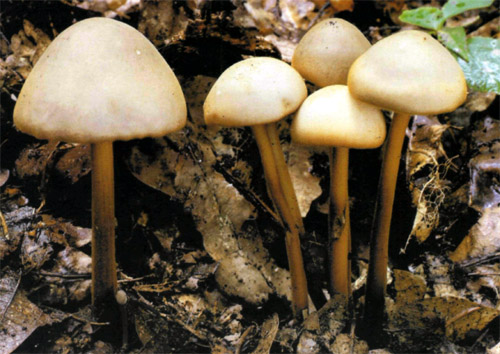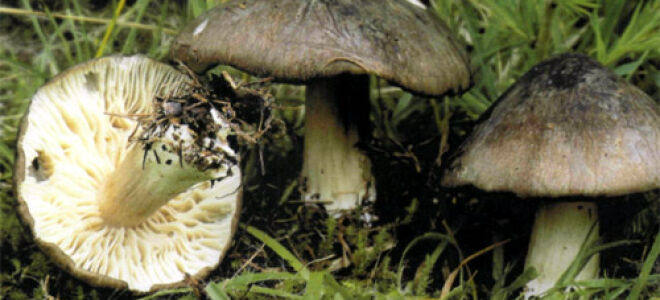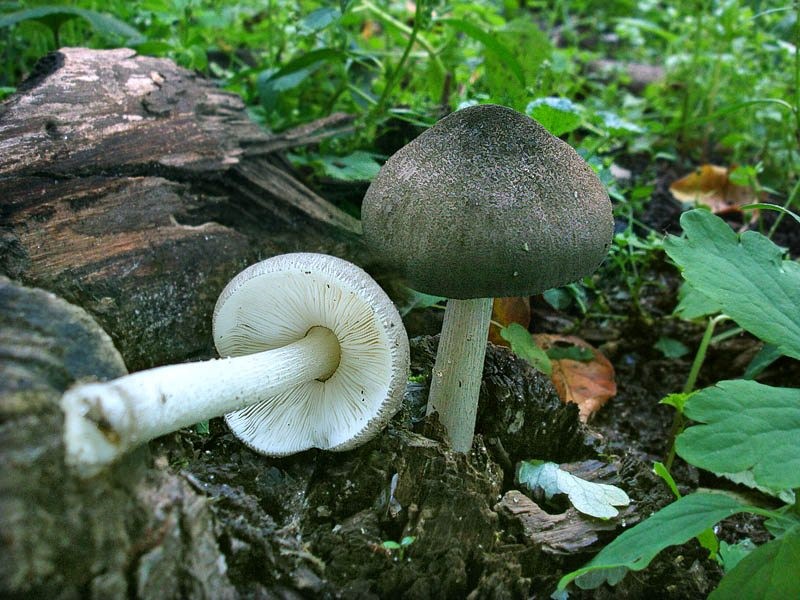Xerula root
Xerula root - Latin Xerula radicata
In another way, this delicate fungus is called Udemansiella root, Xerula rooting, Colibia tailed, Udemansiella root, Odimansiella radiant, Money root or Odimancela root.
Description
Mushroom cap
Outwardly, Kolibia's tailed hat looks tiny, although in reality its diameter is 20-80 mm. It is visually diminished by a thin leg, more reminiscent of a nail shaft.
Young mushrooms have hemispherical rounded caps; in adult specimens, they open almost to an absolute plane and look like coins with a slight elevation in the middle.
The hat surface is damp and covered with clearly visible wrinkles. It is colored in any of the following shades: grayish brown, olive, dirty yellow. In this case, the colors may vary.
Xerula's rooting hat fills with a delicate, watery, pale flesh.
The hat bottom is formed by sparse plates that grow at a young age and are free at a mature age. The plates are light in color from white to creamy gray.
The fungus is propagated by spores contained in white spore powder.
Stipe
Xerula root has a very long stem, reaching 20 cm in height and 10 mm in thickness, with another 13-15 cm immersed in the ground. The stems often grow twisted and turn brown, turning into almost white from top to bottom. The legs are filled with fibrous pulp.
Xerula root - Latin Xerula radicata
Growing places
Odimansiella radiant grows in mixed and deciduous forests, growing in flat and hilly areas. The ideal medium for the fruiting of this mushroom is rotten wood in the form of stumps and dead wood. Remaining half in the ground, the mushroom grows through the rotten dust and is shown to the light.
The fungus bears fruit singly or in a group of three or more specimens. Fruiting occurs in mid-July - early October.
Edibility
Although the pulp of xerula does not exude a special aroma and does not have a pronounced taste, it is classified as an edible mushroom. Only caps are eaten, since the fibrous flesh after cooking becomes too coarse.
Similar types and differences from them
Edible
Xerula is long-legged. It has the same refined stem and general structure, but differs from Xerula root in a velvety grayish cap.
Inedible
Scaly rods. It looks like a collision with a thin leg and a hat shape, but differs in that its plates do not reach the legs.
Fieldman (Agrocybe)
Agrocybe is a small but vibrant genus that belongs to the Bolbitiaceae family. The Russian name Agrocybe - Polevik - is rarely used; probably because there is no one to apply and there is no time. It cannot be said that ordinary users of the Russian language do not know the mushrooms of this family at all, but it has not yet reached an independent name. Perhaps the reason for this lies in the fact that the "collected" representatives of this genus are ideologically close to champignons (Agaricus), and the others are of little interest besides specialists. And experts are well aware that the genus Agrocybe includes soil saprophytes and xylotrophs, and the latter are abundantly cultivated in the respective countries.
Agrocybe is characterized by a medium size of the fruiting body, a private veil and, most importantly for determining the genus, the tobacco-brown color of the spore powder.
Early polevicAgrocybe praecox
Synonyms: Early flakes Agrocybe early - Russia Polowka wczesna - Poland Spring Agaric - England, UK Agrocybe precoce - France Voreilender Ackerling - Germany
The cap is 3-8 cm wide, in youth it is hemispherical with a distinct “cushion-like pattern”, with age it opens up to spread. The color is vaguely yellowish, light clay, sometimes fading in the sun to a dirty whitish color. In wet weather, faint signs of "zoning" can be found on the cap. The remains of the private bedspread often remain on the edges of the cap, which gives this mushroom a resemblance to representatives of the genus Psathyrella.The flesh of the cap is whitish, thin, with a pleasant mushroom smell. The plates are rather frequent, wide, adherent with a "tooth"; in youth, light, yellowish, with age, as the spores mature, darken to dirty brown. Spore powder, tobacco brown. The leg is the same color as the cap, darker in the lower part. The stem is hollow, but at the same time very stiff and fibrous. Height 5-8 cm, in the grass it can be higher; thickness up to 1 cm, although usually thinner. In the upper part, the remains of the ring, as a rule, are somewhat darker than the stem itself (they become even darker when the mushroom matures, being decorated with falling spores). The flesh is brownish, especially at the bottom.
Distribution: Occurs from early June to mid-July in gardens, parks, along the edges of forest roads, preferring rich soils; can settle on strongly rotted wood remains. In some seasons, it can bear fruit very abundantly, although it usually comes across less often.
Similar species: Given the timing of growth, it is rather difficult to confuse the early vole with any other fungus. Closely related and outwardly similar species (such as, for example, Agrocybe elatella) are much less common.
Edible: Normal edible mushroom, although some sources indicate bitterness.
In the collector's understanding, Agrocybe praecox is a kind of “unfinished champignon”. Growing conditions, discs darkening with age, strong dependence of size and weight on soil fertility - all this gives the right to treat this field as a champignon for the poor and hasty. Having met an old woman in the forest with a basket of selected agrocybians, I asked what she was collecting. “Why, chamignons, we eat them every year,” she replied. Inspired by this example, I also recruited early agrocytes and treated my friends. Champignons for ourselves and champignons, if you do not go into details, except for our brother, are of little interest to anyone.
Agrocybe erebiaAgrocybe erebia
The hat is 5-7 cm in diameter, at first bell-shaped, sticky, dark brown, brown-chestnut, with a fawn veil, then prostrate, flat, with a wavy-lobed edge, light brown or brown, smooth, shiny, with a raised wrinkled edge. Plates: frequent, adherent with a tooth, sometimes inversely forked, light, then leathery with a light edge. The spore powder is brown. Leg: 5-7 long and about 1 cm in diameter, slightly swollen or fusiform, longitudinally fibrous, with a ring, with a granular bloom above it, striped below. The ring is thin, bent or pendant, striped, gray-brownish. The pulp is thin, cotton-like, pale yellow, grayish-brownish, with a fruity odor. It is considered a conditionally edible mushroom.
Distribution: from the second half of June to autumn, in mixed and deciduous forests (with birch), at the edge of the forest, outside the forest, near roads, in parks, in grass and on bare soil, in groups, rarely.
Link to article for posting on sites
Xerula pudens (Pers.) Singerpenízovka dlouhonohá
Nejedlá hubaVýskyt: VII. - X.
Klobúk / Plodnica:
Klobúk má 30-60 mm v priemere, najprv je zvoncovite klenutý, neskôr plocho rozprestretý, zvyčajne v strede s hrboľom. Býva tuhý a takmer kožovite mäsitý, často lúčovite vráskavý, plavý, plavohnedý alebo červenohnedý, zamatový.
Plodná časť:
Lupene sú 3-8 mm široké, dosť riedke, pri hlúbiku vykrojené alebo takmer voľné, široko bruškaté, biele alebo jemne krémové. Za suchého počasia bývajú nápadne zvlnené.
Hlúbik:
Hlúbik je relatívne dlhý a tenký, zvyčajne 100-180 mm dlhý a 3-8 mm hrubý, valcovitý, hore najtenší, na báze vretenovite zhrubnutý, neskôr býva pokrútený a vráskavý. Je plavohnedý alebo hnedý, zamatový, najprv plný, chrupkovite tvrdý, neskôr dutý. Zakončený je dlhou a tenkou čiernohnedou koreňovitou časťou, ktorá vniká hlboko do substrátu.
Dužina:
Dužina je biela, pod povrchom klobúka a hlúbika niekedy trochu hnedastá, takmer kožovitá a nehnijúca. Chuť má miernu, vôňu slabú, príjemnú.
Výskyt:
Zamatka dlhohlúbiková rastie od júla do októbra jednotlivo alebo aj v malých skupinkách na hnijúcom dreve listnatých stromov, ukrytom pod zemou. Vyskytuje sa najčastejšie v svetlých listnatých lesoch, ale i v sadoch alebo parkoch pod jednotlivými stromami. Je rozšírená v celom miernom pásme severnej pologule.
Je to neškodná huba, ale na jedenie nevhodná, lebo má tuhú a chrupkovitú konzistenciu. Okrem toho je pomerne zriedkavá, a tak pre praktických hubárov bezvýznamná.
Vedecké zaradenie:
Fungi> Basidiomycota> Agaricomycotina> Agaricomycetes> Agaricomycetidae> Agaricales> Physalacriaceae> Xerula
Synonymum:
Agaricus longipes Bull., Herb. Fr. 5: tab. 232 (1785)
Agaricus pudens (Pers.) Pers., Mycol. eur. (Erlanga) 3: 140 (1828)
Agaricus radicatus ß pudens Pers., Syn. meth. fung. (Göttingen) 2: 313 (1801)
Collybia badia Quél. & Le Bret., Compt. Rend. Assoc. Franç. Avancem. Sci. 30 (2): 494 (1902)
Collybia badia (Lucand) J.E. Lange, Dansk bot. Ark. 9 (no. 6): 72 (1938)
Collybia longipes P. Kumm., Führ. Pilzk. (Zwickau): 117 (1871)
Collybia longipes var. badia Quél., Bull. Soc. Amis Sci. Nat. Rouen, Série II 15: 154 (1880)
Collybia longipes var. badia P. Kumm., Führ. Pilzk. (Zwickau): 117 (1871)
Collybia pudens (Pers.) S. Lundell, Fungi Exsiccati Suecici 35-36: 9 (1949)
Collybia radicata var. longipes (P. Kumm.) Rick, Lilloa 2: 265 (1938)
Gymnopus pudens (Pers.) Gray, Nat. Arr. Brit. Pl. (London) 1: 605 (1821)
Marasmius longipes (P. Kumm.) Quél., Flore mycologique de la France et des pays limitrophes: 321 (1888)
Mucidula longipes (P. Kumm.) Boursier, Bull. trimest. Soc. mycol. Fr. 40 (4): 333 (1926)
Oudemansiella badia (Lucand) M.M. Moser, Z. Pilzk. 19: 11 (1955)
Oudemansiella longipes (P. Kumm.) Boursier, in Moser in Gams, Kl. Krypt.-Fl., Edn 2 (Stuttgart) 2b: 88 (1955)
Oudemansiella longipes (P. Kumm.) M.M. Moser, in Gams, Kl. Krypt.-Fl., Rev. Edn 5 (Stuttgart) 2b / 2: 156 (1983)
Oudemansiella longipes (P. Kumm.) M.M. Moser, in Gams, Kl. Krypt.-Fl., Rev. Edn 5 (Stuttgart) 2b / 2: 156 (1983) var. longipes
Oudemansiella pudens (Pers.) Pegler & T.W.K. Young, Trans. Br. mycol. Soc. 87 (4): 590 (1987)
Xerula longipes (P. Kumm.) Maire, Mus. barcin. Scient. nat. Op., Ser. Bot. 15: 66 (1933)
Autor popisu:
Hlavná úprava: Mgr. Roland Baranovič (11.05.2001)
Zmeny vykonali: Paľo ° (21.12.2011), Erik Brozmann (07.09.2010)
Akcie:
Aktuálne nemáme žiadne fotografie tohoto druhu.
Zobraziť viac
Neexistujú ďalšie fotografie
Skrátiť zoznam
Xerula (kollibia) leggy: photo and description
| Name: | Xerula long-legged |
| Latin name: | Xerula pudens |
| Type of: | Edible |
| Synonyms: | Collybia longipes, Xerula longipes, Collybia longipes, Oudemansiella longipes |
| Systematics: |
|
Xerula long-legged is an edible mushroom that affects mushroom pickers with a very long, thin leg and a rather large cap. Often the species is confused with a poisonous specimen and passes by, not knowing that the mushroom has a good aroma and taste. But before collecting unfamiliar varieties, you need to study the description and carefully look at the photo so as not to collect false doubles in the basket.
What does Xerula long-legged look like?
Xerula long-legged, or Hymnopus long-legged, is an interesting representative of the mushroom kingdom. In order not to be mistaken in the choice, you must first have an idea of the appearance of the mushroom:
Description of the hat
This species is distinguished by a small cap, up to 80 mm in diameter. At a young age, it is convex, straightens with age, and the edges are bent upward. The central tubercle remains, then depressions and wrinkles appear. Dry, velvety, dense skin is colored lemon brown or dark gray. On the lower part there are rare snow-white plates, partially connected to the leg.
Xerula reproduces by colorless elliptical spores in a spore powder.
Leg description
The species got its name because of the thin, very long legs. Its thickness is about 30 mm, and its length is up to 15 cm. The leg is buried in the ground, which makes the mushroom more resistant. The shape can be round-cylindrical or flat. Thin velvety scales are colored to match the color of the cap.
Is the mushroom edible or not
A rare specimen is edible. It has snow-white tasty pulp, with a light pleasant aroma. Therefore, delicious stewed, salted, pickled and fried dishes are obtained from it.
Where and how it grows
The long-legged hymnopus is a rare specimen. It prefers to grow on stumps, in the dust, on the roots of deciduous trees. The fungal representative grows in small groups. The fruiting period is July-October.
Doubles and their differences
In order not to be mistaken during mushroom hunting, you need to know that Gymnopus has doubles. These include:
Collibia root is an edible species, very similar to a long nail with a small slimy cap, colored brown. When squeezed, the root part does not change shape and remains rounded.
Scaly plyute is an inedible specimen, which is distinguished by a gray cap with not adherent plates. Fruiting occurs from late spring to early July
Important! Scaly barnacles can cause food poisoning. Collibia spindle-footed - a poisonous variety
It has a tough flesh and a reddish-brown cap that discolors with age. Fruiting occurs from late spring to mid-summer.
Xerula hairy - refers to the conditionally edible representatives of the mushroom kingdom. You can recognize it by a long leg and a large hat with a fleecy bottom. In adult specimens, the edges are strongly curved upward, which makes it easy to see thin plates. Prefers to grow in groups in mixed forests. Fruiting occurs from mid-summer to late September.
Conclusion
Long-legged Xerula is a rare species that prefers to grow in deciduous forests. The edible mushroom, thanks to its delicious pulp and delicate aroma, is used to prepare a variety of dishes.

